History
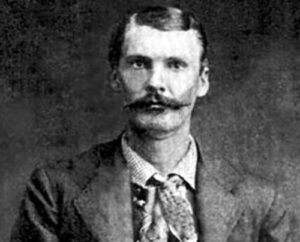 Most gunfighters in the Old West, either used their own names, or came up with a tough sounding gunfighter name, but somehow, John Calhoun Pinckney Higgins ended up with the rather feminine sounding name of “Pink.” Of course, it came from his second middle name, and may have even started as a childhood nickname. Nevertheless, John Calhoun Pinckney Higgins went by the gunfighter’s name of “Pink.”
Most gunfighters in the Old West, either used their own names, or came up with a tough sounding gunfighter name, but somehow, John Calhoun Pinckney Higgins ended up with the rather feminine sounding name of “Pink.” Of course, it came from his second middle name, and may have even started as a childhood nickname. Nevertheless, John Calhoun Pinckney Higgins went by the gunfighter’s name of “Pink.”
Higgins was a Texas gunfighter who was involved in the Horrell-Higgins Feud. The Horrell and Higgins families were friends and neighbors until the 1870s. The ranchers had settled in Lampasas County before the Civil War era. The five Horrell brothers…Mart, Tom, Merritt, Ben, and Sam first got into trouble with the State Police in 1873, when Captain Thomas Williams and seven men went to Lampasas to put a stop to the general lawlessness that was prevalent there. Williams fought with the Horrell boys and their brother-in-law, Bill Bowen, in Jerry Scott’s saloon. Mart Horrell who was badly wounded, was confined in the Georgetown jail, but as soon as he was well enough his brothers helped him to break out.
The relationship between the Horrells and Higgins blew up when, at the same time, because Pink’s son-in-law 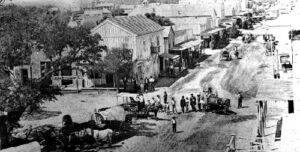 was also killed in the shootout. Soon, a vicious feud between the two families erupted, referred to as the Horrell-Higgins Feud. Over a several-year period, several shooting scrapes occurred, finally culminating in a shoot-out in the Lampasas town square on June 14, 1877, in which several men were killed. A few more skirmishes occurred before the feud was said and done.
was also killed in the shootout. Soon, a vicious feud between the two families erupted, referred to as the Horrell-Higgins Feud. Over a several-year period, several shooting scrapes occurred, finally culminating in a shoot-out in the Lampasas town square on June 14, 1877, in which several men were killed. A few more skirmishes occurred before the feud was said and done.
Around 1900, Higgins moved his ranch to the south of Spur, Texas. He continued his gunfighting ways and was said to have killed between 14-18 men during his lifetime. He died at his ranch of a heart attack on December 18, 1914.

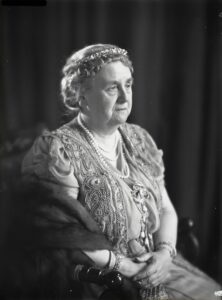 When a monarch becomes incapacitated or becomes monarch while under the age of 18, they can be placed under a regency, which became the normal procedure in 1937, with the passing of The Regency Acts. Prior to 1937, Regency Acts were passed only when necessary to deal with a specific situation. The Regency Act simply placed an adult, often a parent, or in the case of an incapacitated monarch, a spouse, in an advisory position over the monarch. The passing of The Recency Acts of 1937 made the procedure easier, because they realized that it could happen at any time.
When a monarch becomes incapacitated or becomes monarch while under the age of 18, they can be placed under a regency, which became the normal procedure in 1937, with the passing of The Regency Acts. Prior to 1937, Regency Acts were passed only when necessary to deal with a specific situation. The Regency Act simply placed an adult, often a parent, or in the case of an incapacitated monarch, a spouse, in an advisory position over the monarch. The passing of The Recency Acts of 1937 made the procedure easier, because they realized that it could happen at any time.
Wilhelmina Helena Pauline Maria, born August 31, 1880, was Queen of the Netherlands from 1890 until her abdication in 1948…reigning for nearly 58 years. Her reign was longer than any other Dutch monarch. The First and the Second World Wars, as well as the Dutch economic crisis of 1933, all took place during her reign. The really unusual thing about Queen Wilhelmina was that she became queen at the tender age of just 10 years old, under her mother, Emma of Waldeck and Pyrmont’s regency. Her father, King William III’s passing in 1890 brought about her ascension to the throne. Wilhelmina was their only child, and just a little girl, but that did not mean that she was incapable.
Following her ascension to the throne, Wilhelmina proved herself to be a great monarch. In a popular decision, she maintained Dutch neutrality during the First World War, while also solving many of her country’s industrial problems. Her successful business ventures made her the world’s first female billionaire in dollars. She also ensured that her family was one of seven European royal houses remaining in existence to this day. Of course, all that didn’t save her country from the German invasion of the Netherlands in 1940. At that time, Queen Wilhelmina was encouraged to flee to Britain, where she took charge of the Dutch government-in-exile. That did not mean that she was out of the spotlight and out of reach to her people. She frequently spoke to the nation over radio and came to be regarded as a symbol of the resistance. By 1948, she had already returned to the liberated Netherlands. She was the only survivor of the 16 monarchs who were sitting on their thrones at the time of her coronation.
By 1948, with her health declining, Wilhelmina abdicated the throne in favor of her daughter Juliana in  September of that year, and she retired to Het Loo Palace, where she died of cardiac arrest at the age of 82 on November 28, 1962. She was buried in the Dutch royal family crypt in the Nieuwe Kerk in Delft, on December 8, 1962. At her request and contrary to protocol, the funeral was completely in white to give expression to her belief that earthly death was the beginning of eternal life…something I really like. According to German Salic law, the House of Orange-Nassau-Dietz became extinct upon her death, but this rule is not recognized by royal Dutch succession laws. That law seems odd to me considering that her daughter, became queen after she abdicated.
September of that year, and she retired to Het Loo Palace, where she died of cardiac arrest at the age of 82 on November 28, 1962. She was buried in the Dutch royal family crypt in the Nieuwe Kerk in Delft, on December 8, 1962. At her request and contrary to protocol, the funeral was completely in white to give expression to her belief that earthly death was the beginning of eternal life…something I really like. According to German Salic law, the House of Orange-Nassau-Dietz became extinct upon her death, but this rule is not recognized by royal Dutch succession laws. That law seems odd to me considering that her daughter, became queen after she abdicated.
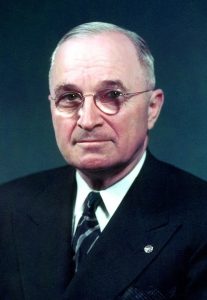 Some presidents are destined to greatness, and some are thrown into it. Some qualify in both categories. President Harry S Truman was born in Lamar, Missouri, on May 8, 1884. He was the oldest child of John Anderson Truman and Martha Ellen Young Truman. As is often tradition in families, he was named for his maternal uncle, Harrison “Harry” Young. His middle initial, “S” was to honor his grandfathers, Anderson Shipp Truman and Solomon Young. Truman’s brother, John Vivian, was born soon after he was, followed by sister Mary Jane.
Some presidents are destined to greatness, and some are thrown into it. Some qualify in both categories. President Harry S Truman was born in Lamar, Missouri, on May 8, 1884. He was the oldest child of John Anderson Truman and Martha Ellen Young Truman. As is often tradition in families, he was named for his maternal uncle, Harrison “Harry” Young. His middle initial, “S” was to honor his grandfathers, Anderson Shipp Truman and Solomon Young. Truman’s brother, John Vivian, was born soon after he was, followed by sister Mary Jane.
President Truman was the 33rd President of the United States, becoming president after the death of President Franklin D Roosevelt. He was a lifetime Democrat, although he might not recognize the party today, and as we have seen, there are good and bad politicians in both parties. Following the death of Roosevelt, who was rather anti-Israel, Truman implemented the Marshall Plan to rebuild the economy of Western Europe and established both the Truman Doctrine and NATO to contain the expansion of communism. He went on to propose numerous liberal domestic reforms, but few were enacted by the Conservative Coalition that dominated the Congress at 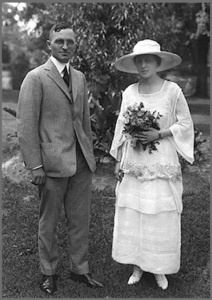 that time. While some of his policies, were not good for America or the world, he was known for his support of Israel. On May 14, 1948, Prime Minister David Ben-Gurion read the proclamation of nationhood. Striking the speaker’s table for emphasis, he announced, “The name of our state shall be Israel.” It was a noble effort, but the new state would need to be recognized to carry much weight.
that time. While some of his policies, were not good for America or the world, he was known for his support of Israel. On May 14, 1948, Prime Minister David Ben-Gurion read the proclamation of nationhood. Striking the speaker’s table for emphasis, he announced, “The name of our state shall be Israel.” It was a noble effort, but the new state would need to be recognized to carry much weight.
Shortly before making his speech, President Truman made some last-minute changes, which are still visible on the speech. The American statement recognized the new State of Israel. Israel’s American recognition came shortly after midnight in Palestine, just a few minutes after the new nation was proclaimed. There were a number of nations who did not want Israel to be a nation again, but President Truman took matters into his own hands, and it became a reality. For his help, President Truman was gifted a Torah from Dr Chaim Weizmann, who was the first president of the new state of Israel, during Weizmann’s visit to the White House on May 25th, 1948. I suppose some people might disagree, but for me, this was the crowning moment of Truman’s presidency.
After his wartime service, Truman returned to Independence, where he married Bess Wallace on June 28, 1919. 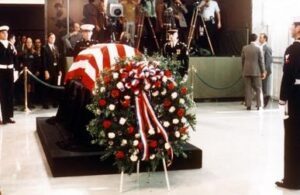 The couple had one child, Mary Margaret Truman. On December 5, 1972, Truman was admitted to Kansas City’s Research Hospital and Medical Center with pneumonia. He developed multiple organ failure, fell into a coma, and died at 7:50am on December 26, 1972, in Independence, Missouri at the age of 88. Bess Truman opted for a simple private service at the library rather than a state funeral in Washington. A week after the funeral, foreign dignitaries and Washington officials attended a memorial service at Washington National Cathedral. Bess died in 1982 and is buried next to Harry at the Harry S Truman Library and Museum in Independence, Missouri.
The couple had one child, Mary Margaret Truman. On December 5, 1972, Truman was admitted to Kansas City’s Research Hospital and Medical Center with pneumonia. He developed multiple organ failure, fell into a coma, and died at 7:50am on December 26, 1972, in Independence, Missouri at the age of 88. Bess Truman opted for a simple private service at the library rather than a state funeral in Washington. A week after the funeral, foreign dignitaries and Washington officials attended a memorial service at Washington National Cathedral. Bess died in 1982 and is buried next to Harry at the Harry S Truman Library and Museum in Independence, Missouri.
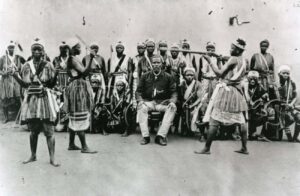 The Dahomey Amazons were given a number of different names, but the Mino, as they were called, were mostly an army recruited from among the king’s wives. They were a large group of 4,000 to 6,000 female warriors. Strangely, they made up about one third of the overall Dahomey military. King Houegbadja, who ruled from 1645 to 1685…the third King of Dahomey, is said to have originally started the group which would become the Amazons as a corps of elephant hunters called the gbeto. They were commonly known as Mino or “our mothers” and were the royal bodyguards of the kings of Dahomey, which is currently the Republic of Benin.
The Dahomey Amazons were given a number of different names, but the Mino, as they were called, were mostly an army recruited from among the king’s wives. They were a large group of 4,000 to 6,000 female warriors. Strangely, they made up about one third of the overall Dahomey military. King Houegbadja, who ruled from 1645 to 1685…the third King of Dahomey, is said to have originally started the group which would become the Amazons as a corps of elephant hunters called the gbeto. They were commonly known as Mino or “our mothers” and were the royal bodyguards of the kings of Dahomey, which is currently the Republic of Benin.
These women might have been the wives of the king, but that did not make  them wimps. Their training was intense and fierce. They learned survival skills and indifference to pain and death, storming acacia-thorn defenses in military exercises and executing prisoners. Discipline was emphasized. Once trained, the Mino were known to fight with incredible bravery and “audacity.” Due to the profits from the slave trade, they were also armed with Danish flintrocks and Winchester repeaters, which would come in handy when they took on the French army.
them wimps. Their training was intense and fierce. They learned survival skills and indifference to pain and death, storming acacia-thorn defenses in military exercises and executing prisoners. Discipline was emphasized. Once trained, the Mino were known to fight with incredible bravery and “audacity.” Due to the profits from the slave trade, they were also armed with Danish flintrocks and Winchester repeaters, which would come in handy when they took on the French army.
The kings recruited both men and women soldiers from foreign captives, though women soldiers were also recruited from free Dahomean women. Some of these “women” enrolled as young as 8 years old, if you can call an 8-year-old girl a woman. Some women in Fon society became soldiers voluntarily, while others were involuntarily enrolled, if their husbands or fathers complained to the king about their behavior. Imagine that…but then times were different. Apparently, membership among the Mino was supposed to teach them to use any aggressive character traits for the purpose of war. During their membership they were not allowed to have 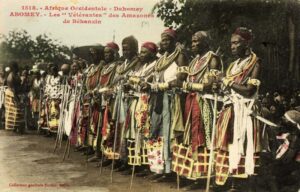 children or be part of married life, although many were legally married to the king. Serving in the Mino offered women the opportunity to “rise to positions of command and influence” in an environment structured for individual empowerment. The Mino were also wealthy and held high status. These women were true fighters and very determined. In a bold move, King Behanzin started a war with France in 1890. Despite being a formidable force, the French lost several major battles against the Mino early on. It just goes to show that women can be warriors too. These women were a long-standing force. The last known member of the Dahomey Amazons died in 1979.
children or be part of married life, although many were legally married to the king. Serving in the Mino offered women the opportunity to “rise to positions of command and influence” in an environment structured for individual empowerment. The Mino were also wealthy and held high status. These women were true fighters and very determined. In a bold move, King Behanzin started a war with France in 1890. Despite being a formidable force, the French lost several major battles against the Mino early on. It just goes to show that women can be warriors too. These women were a long-standing force. The last known member of the Dahomey Amazons died in 1979.
 As Christmas approaches, with all of its feasts, we start thinking of all the goodies we will make and eat. For many people, pie is a big part of holiday meals, not to mention other meals year-round. People just simply love pie. They would bake them to share or give as gifts, and especially to have with tea when guests came by, but the one thing I can’t imagine is any kind of worship involving pie. Nevertheless…
As Christmas approaches, with all of its feasts, we start thinking of all the goodies we will make and eat. For many people, pie is a big part of holiday meals, not to mention other meals year-round. People just simply love pie. They would bake them to share or give as gifts, and especially to have with tea when guests came by, but the one thing I can’t imagine is any kind of worship involving pie. Nevertheless…
In 1644, an English statesman named Oliver Cromwell, came up with the totally irrational idea that pie was a pagan form of pleasure, so he banned pie. The eating of pie, baking pies, even thinking about pie. Well, maybe not exactly, but for the next sixteen years, no one could eat pie. So, like the prohibition years that would come about in the future, the eating of pie went…underground.
I can’t imagine having to bake and eat a pie in secret. For one thing, you can smell a pie baking. The aroma fills the house, and in the 1600s, they didn’t have a conventional oven like we have today. Dutch ovens were the first ovens used for baking. The pot would be embedded in the hot coals and ashes, and then more coals would be placed on its flat lid. Really, any large iron pot could be used as a Dutch oven. Double boilers were also used at this time. This meant that the aroma of the pie filled the area even more, because of the open chimney or the open pit in the outdoors where the pie was baked. I’m not sure if a violation of this new prohibitive law was a fine, jail, or death, but it was certainly something that made people realize that they must really want to bake that pie, if they would take such a risk for the chance to bake one.
Finally, in 1660, the Restoration leaders lifted the ban on pie baking, and the people rejoiced. I don’t know if  they went as crazy about getting back to eating pie as they did the end of the Prohibition years, but I would imagine that there were a few gatherings to celebrate the new-found freedom. These days we can’t imagine such a silly idea concerning pie, but with every revelation, there must first have been a misconception. Oliver Cromwell somehow saw something in pie that made him believe the way he did, so seriously that he would make a law. Perhaps, it was his own addiction to pie that made him think it must be bad…not that I know that he was addicted to pie, but people have given up food and drink items for that reason for centuries. In fact, people have had confused ideas when it comes to religion for centuries.
they went as crazy about getting back to eating pie as they did the end of the Prohibition years, but I would imagine that there were a few gatherings to celebrate the new-found freedom. These days we can’t imagine such a silly idea concerning pie, but with every revelation, there must first have been a misconception. Oliver Cromwell somehow saw something in pie that made him believe the way he did, so seriously that he would make a law. Perhaps, it was his own addiction to pie that made him think it must be bad…not that I know that he was addicted to pie, but people have given up food and drink items for that reason for centuries. In fact, people have had confused ideas when it comes to religion for centuries.
 Sometimes, when a country is in turmoil, and there seems to be no way out, the only choice is to have an outside invasion…from a foreign power. Panama was in such a situation in 1989, and so on December 20, 1989, the United States Army spearheaded a carefully planned and well-executed attack designed to overwhelm the Panamanian Defense Forces (PDF) of dictator Manuel Noriega, who was a convicted drug trafficker and a brutal dictator. He rose to power when he joined the military and then quickly rose through the ranks. He was very motivated, and most likely had a planned agenda from the start. Once he was in power his brutality as well as his interference with activities in the Panama Canal area, got worse and worse. Something had to be done.
Sometimes, when a country is in turmoil, and there seems to be no way out, the only choice is to have an outside invasion…from a foreign power. Panama was in such a situation in 1989, and so on December 20, 1989, the United States Army spearheaded a carefully planned and well-executed attack designed to overwhelm the Panamanian Defense Forces (PDF) of dictator Manuel Noriega, who was a convicted drug trafficker and a brutal dictator. He rose to power when he joined the military and then quickly rose through the ranks. He was very motivated, and most likely had a planned agenda from the start. Once he was in power his brutality as well as his interference with activities in the Panama Canal area, got worse and worse. Something had to be done.
The election had been stolen, of course, and the United States, along with several other nations, needed to take back the area from the imposter, and restore the democratically elected government of Guillermo Endara, followed by the arrest of Noriega on drug trafficking charges. This was going to be the largest and most complex combat operation since the Vietnam War. Labeled, Operation Just Cause, and with nearly 26,000 combat troops deployed, just under half being from bases in the United States, the operation began. Two dozen targets were attacked throughout the country that day, using a wide spectrum of tactical operations including Military Operations on Urbanized Terrain (MOUT), Air-Assault, Airborne, and Special Forces. The operation was carefully planned out and conducted so as to take into account both parts of the mission…the operational aspects, as well as the political implications of forcibly removing Noriega from power. Not everyone in the world would look at this as being a justified operation. Through emphasis on realistic small-unit training, the U.S. Army successfully accomplished its mission. They decisively neutralized Noriega’s forces, restoring the elected democratic government, protecting American lives, and minimizing Panamanian casualties.
Initially planned as a gradual buildup of combat troops from the United States, the plan was significantly 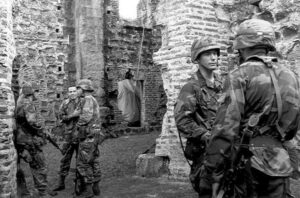 modified in early 1989 after Noriega increased attempts to intimidate American civilians and soldiers and after he orchestrated assaults against newly elected anti-Noreiga candidates. He was becoming too volatile to be allowed to continue his reign, so President George H W Bush ordered an additional 1,900 combat troops to Panama to increase security of American personnel and property, an operation known as known as Operation Nimrod Dancer…where do they get some of these names? He also appointed General Maxwell Thurman as the new US Southern Command commander. General Thurman envisioned the operation as a rapid take-down of the Panamanian Defense Forces, slightly different than President Bush saw it. Thurman wanted to capture Noriega quickly in order to prevent his troops from moving into the country’s interior in order to form an insurgency.
modified in early 1989 after Noriega increased attempts to intimidate American civilians and soldiers and after he orchestrated assaults against newly elected anti-Noreiga candidates. He was becoming too volatile to be allowed to continue his reign, so President George H W Bush ordered an additional 1,900 combat troops to Panama to increase security of American personnel and property, an operation known as known as Operation Nimrod Dancer…where do they get some of these names? He also appointed General Maxwell Thurman as the new US Southern Command commander. General Thurman envisioned the operation as a rapid take-down of the Panamanian Defense Forces, slightly different than President Bush saw it. Thurman wanted to capture Noriega quickly in order to prevent his troops from moving into the country’s interior in order to form an insurgency.
Training began in May 1989, and the early preparation and training was a key for the success of Operation Just Cause. The 193rd Infantry Brigade, which was the primary combat unit stationed near Panama City, increased the number of live-fire exercises and MOUT training. At that time, there were no MOUT training sites available, so battalion commanders adapted by constructing makeshift buildings for live-fire exercises. Soldiers practiced room-clearing as well as prisoner control, using the barracks. Soon to be sent to Panama…once the operation began, units of the 82nd Airborne Division and the 7th Infantry Division also increased training. The Panamanian Defense units were very close to the location of the American operations, so operational planners and unit commanders took advantage of increased security measures. These training exercises, Code-named Sand Flea, represented deliberate demonstrations of force aimed at securing American facilities. The good news 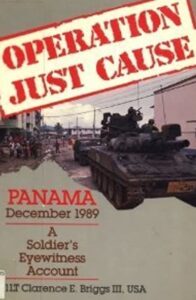 was that troops were familiar with their targets, since many of these facilities needed to be secured or were used as staging areas for the invasion. In addition, the exercises were run with such frequency that the enemy became desensitized to rapid movements of troops, helping to maintain the element of surprise that was crucial to success. For me, it still seems like they should have suspected something.
was that troops were familiar with their targets, since many of these facilities needed to be secured or were used as staging areas for the invasion. In addition, the exercises were run with such frequency that the enemy became desensitized to rapid movements of troops, helping to maintain the element of surprise that was crucial to success. For me, it still seems like they should have suspected something.
In the end, the careful planning and intensive training paid off. The operation was a good success, despite its complexity. The plan showed the ability to work with the military and political goals to rapidly destroy the enemy’s ability to fight They also managed to fight without needlessly endangering Panamanian lives or property. The training was a great success. The troops were able to quickly adapt to the unforeseen challenges of combat. Major military operations took only five days. Noriega surrendered on January 3rd and by January 12tb, Operation Just Cause was over. In less than a month, the US Army and other American Armed Forces had achieved complete victory.
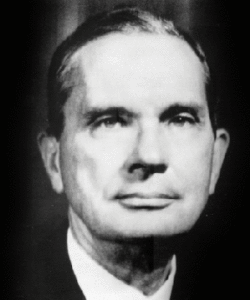 During their reign of terror, Japan, like Germany had their sights set on world domination. Japanese troops landed in Hong Kong on December 18, 1941, and an immediate slaughter began. The process started with a week of air raids over Hong Kong, which was a British Crown Colony at the time. Then on December 17, Japanese envoys paid a visit to Sir Mark Young, who was at that time, the British governor of Hong Kong.
During their reign of terror, Japan, like Germany had their sights set on world domination. Japanese troops landed in Hong Kong on December 18, 1941, and an immediate slaughter began. The process started with a week of air raids over Hong Kong, which was a British Crown Colony at the time. Then on December 17, Japanese envoys paid a visit to Sir Mark Young, who was at that time, the British governor of Hong Kong.
The envoys’ message was simple: “The British garrison there should simply surrender to the Japanese—resistance was futile.” The envoys were sent home with the following retort: “The governor and commander in chief of Hong Kong declines absolutely to enter into negotiations for the surrender of Hong Kong…”
The unsuccessful negotiations brought a swift wave of Japanese troops, who in retaliation for the refused surrender, landed in Hong Kong with artillery fire for cover and the following order from their commander: “Take no prisoners.” The troops quickly overran a volunteer antiaircraft battery, and the Japanese invaders roped together the captured soldiers. In a complete disregard for human life, a complete disregard for the Geneva Convention rules, or any rules of common decency, the Japanese proceeded to bayonet them to death. Even those who offered no 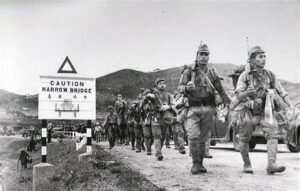 resistance, such as the Royal Medical Corps, were led up a hill and killed. They showed no mercy, just hate and evil. Following the initial slaughter, the Japanese took control of key reservoirs. With the water under their control, they threatened the British and Chinese inhabitants with a slow death by thirst. With their backs against a wall, the British finally surrendered control of Hong Kong on Christmas Day.
resistance, such as the Royal Medical Corps, were led up a hill and killed. They showed no mercy, just hate and evil. Following the initial slaughter, the Japanese took control of key reservoirs. With the water under their control, they threatened the British and Chinese inhabitants with a slow death by thirst. With their backs against a wall, the British finally surrendered control of Hong Kong on Christmas Day.
On that same day, the War Powers Act was passed by Congress, authorizing the president to initiate and terminate defense contracts, reconfigure government agencies for wartime priorities, and regulate the freezing of foreign assets. It also permitted him to censor all communications coming in and leaving the country. President Franklin D Roosevelt appointed the executive news director of the Associated Press, Byron Price, as director of censorship. Although invested with the awesome power to restrict and withhold news, Price took no extreme measures, allowing news outlets and radio stations to self-censor, which they did. Most top-secret information, including the construction of the atom 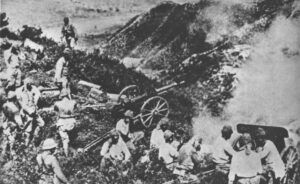 bomb, remained just that…strangely, but then those were different times.
bomb, remained just that…strangely, but then those were different times.
“The most extreme use of the censorship law seems to have been the restriction of the free flow of “girlie” magazines to servicemen…including Esquire, which the Post Office considered obscene for its occasional saucy cartoons and pinups. Esquire took the Post Office to court, and after three years the Supreme Court ultimately sided with the magazine.” It amazes me just how much times have changed. These days the “girlie” trash is totally acceptable, but truth is censored and lies are allowed. Too bad we are so far out from those days.
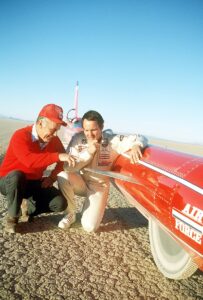 We all know what it means to travel faster than the speed of sound…at least in theory. And most of us believe that it takes an airplane to accomplish that feat. That said, I wonder how Hollywood stuntman Stan Barrett felt when, on December 17, 1979, he blasted across a dry lakebed at California’s Edwards Air Force Base in a rocket and missile-powered car, becoming the first man to travel faster than the speed of sound on land. The reality is that there is no proof that he actually accomplished what he set out to do, which was to see if he could go faster than the speed of sound, because unfortunately, the radar scanner was acting up, and so Barrett’s top speed of 739.666 miles per hour by the most reliable measure, ended up being no more than an estimate. In addition, he only drove his rocket car across the lakebed once, while official record guidelines require that it be done twice. Also, none of the spectators heard a sonic boom as Barrett zoomed across the course. Nevertheless, it is believed that he did indeed break the sound barrier.
We all know what it means to travel faster than the speed of sound…at least in theory. And most of us believe that it takes an airplane to accomplish that feat. That said, I wonder how Hollywood stuntman Stan Barrett felt when, on December 17, 1979, he blasted across a dry lakebed at California’s Edwards Air Force Base in a rocket and missile-powered car, becoming the first man to travel faster than the speed of sound on land. The reality is that there is no proof that he actually accomplished what he set out to do, which was to see if he could go faster than the speed of sound, because unfortunately, the radar scanner was acting up, and so Barrett’s top speed of 739.666 miles per hour by the most reliable measure, ended up being no more than an estimate. In addition, he only drove his rocket car across the lakebed once, while official record guidelines require that it be done twice. Also, none of the spectators heard a sonic boom as Barrett zoomed across the course. Nevertheless, it is believed that he did indeed break the sound barrier.
Barrett, who was a 36-year-old stuntman and ex-lightweight Golden Glove champion, was introduced to auto racing by Paul Newman in 1971. At the time, he was Newman’s stunt double for the film “Sometimes a Great Notion.” Barrett’s car, the $800,000 Budweiser Rocket, was owned by movie director, Hal  Needham, who was himself a former racer. Needham had broken a nine-year-old world land-speed record on the Bonneville Salt Flats the previous September. The car he drove had a 48,000-horsepower rocket engine and, to give it a little extra kick, a 12,000-horsepower Sidewinder missile.
Needham, who was himself a former racer. Needham had broken a nine-year-old world land-speed record on the Bonneville Salt Flats the previous September. The car he drove had a 48,000-horsepower rocket engine and, to give it a little extra kick, a 12,000-horsepower Sidewinder missile.
December 17th was a dry day with temperatures around 20° Fahrenheit. Because of the cold, Barrett would actually have to go faster than the 731.9 miles per hour required, in order to break the sound barrier under those conditions. He started the rocket engine and stepped on the gas. He counted to 12, pushed the button on his steering wheel to fire the Sidewinder, so he could go even faster. After he zoomed past a battery of timing devices, Barrett deployed a parachute to help him slow down. It took only a few seconds for Barrett to blast across the 5¾ mile long lakebed. Most of us would have a hard time wrapping our heads around that.

The run was perfect, but unfortunately, the radar speedometers on the ground malfunctioned. Instead of recording the Rocket’s speed, they captured the speed of a passing truck, which was only 38 miles per hour. They would have to look elsewhere for confirmation, and in the end, the speed estimate came from data by the Air Force, whose scanners seemed to indicate that the Rocket had “probably exceeded the speed of sound.” The controversy over how fast Barrett actually went is still disputed to this day. It took until October 1997 for another driver, in a British car called the Thrust SSC, to officially break the Mach 1 sound barrier.
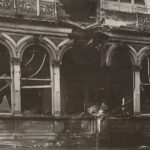
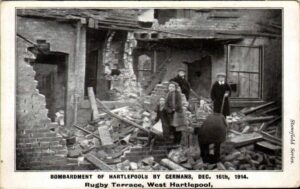 Any army is going to try attack the enemy in a sneaky way, so that their enemy is not ready…and indeed, has no idea the enemy is even nearby. When it comes to sneak attacks, we often think about the Japanese and Pearl Harbor, but they were not the only ones to do it. The Germans were just as likely to sneak up on their targets as the Japanese.
Any army is going to try attack the enemy in a sneaky way, so that their enemy is not ready…and indeed, has no idea the enemy is even nearby. When it comes to sneak attacks, we often think about the Japanese and Pearl Harbor, but they were not the only ones to do it. The Germans were just as likely to sneak up on their targets as the Japanese.
At approximately 8am on December 16, 1914, Franz von Hipper sent German battle cruisers from his Scouting Squadron to attack the British navy. The attack caught the British completely by surprise, as the Germans began heavy bombardment of Hartlepool and Scarborough…two English port cities on the North 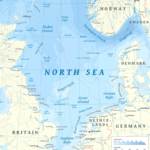 Sea. In the attack that lasted an hour and a half, the Germans killed more than 130 civilians and wounded another 500. The attack brought a swift and vicious response from the British press, who called the incident another example of German brutality. The German navy countered that the two port cities were valid targets due to their fortified status. It didn’t justify the attack, but it was the excuse the Germans used.
Sea. In the attack that lasted an hour and a half, the Germans killed more than 130 civilians and wounded another 500. The attack brought a swift and vicious response from the British press, who called the incident another example of German brutality. The German navy countered that the two port cities were valid targets due to their fortified status. It didn’t justify the attack, but it was the excuse the Germans used.
The attack was quickly answered by the British. Two defense batteries in Hartlepool were dispatched to attack the German vessels, damaging three of them, including the heavy cruiser, Blucher. Hipper’s plan was to draw the British forces to pursue them across waters freshly laced with mines. They also had another German fleet, commanded by Admiral Friedrich von Ingenohl, waiting offshore to provide support. The plan fell through when the hoped-for major confrontation did not take place. Instead, the British decided to keep most of their fleet, which had been depleted by the dispatch of their major cruisers to pursue the dangerous squadron of Admiral Maximilian von Spee, in the harbor.

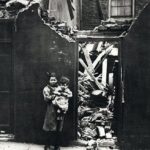
The Scouting Squadron attempted a repeat attack one month later using the same tactics used to surprise the British at Scarborough and Hartlepool. That attempt resulted in the Battle of Dogger Bank, where Hipper’s squadron was defeated, but unfortunately managed to avoid capture. The biggest drawback of a sneak attack is that it can really only be used once. After that the enemy is prepared and watching.
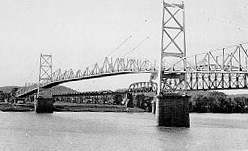
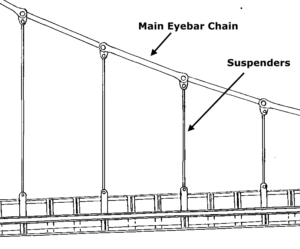 Over time, architecture has taken many turns. Some buildings last for thousands of years, and others struggle to last a hundred years. Also, some structures go through more things that can degrade them, such as the elements and usage. Such as the case with the Silver Bridge. The Silver Bridge was built in 1928 and connected Point Pleasant, West Virginia with Gallipolis, Ohio via US Route 35, taking it over the Ohio River. It was an eyebar-chain suspension bridge. The bridge got its name from the color of its aluminum paint.
Over time, architecture has taken many turns. Some buildings last for thousands of years, and others struggle to last a hundred years. Also, some structures go through more things that can degrade them, such as the elements and usage. Such as the case with the Silver Bridge. The Silver Bridge was built in 1928 and connected Point Pleasant, West Virginia with Gallipolis, Ohio via US Route 35, taking it over the Ohio River. It was an eyebar-chain suspension bridge. The bridge got its name from the color of its aluminum paint.
The bridge was less that 40 years old when disaster struck on December 15, 1967. It is said that the bridge 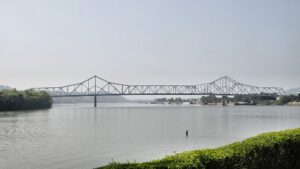 collapsed under the weight of rush-hour traffic, but that seems extreme to me. How many cars would it take to break a bridge, and how would they all fit on the bridge to make it break? When the bridge came down, 46 people lost their lives. Search and rescue operations were immediately put in place, and 44 people were found, but two of the victims were never found. When the bridge was rebuilt in 1969, it would be both a bridge and a memorial to those who lost their lives that fateful day.
collapsed under the weight of rush-hour traffic, but that seems extreme to me. How many cars would it take to break a bridge, and how would they all fit on the bridge to make it break? When the bridge came down, 46 people lost their lives. Search and rescue operations were immediately put in place, and 44 people were found, but two of the victims were never found. When the bridge was rebuilt in 1969, it would be both a bridge and a memorial to those who lost their lives that fateful day.
No such disaster can take place without an investigation following it, to determine the cause. The causes of these disasters actually help to correct the flaws so that things like this don’t happen in the future. The investigation into the cause of the Silver Bridge collapse came down to the failure of just one eyebar. I suppose that once that one gave way, the load was too much for the rest of the eyebar links. It was further determined that the eyebar that failed had a 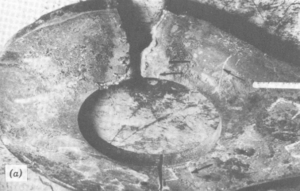
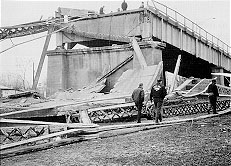 small defect 0.1 inches deep. The analysis showed that the bridge was carrying much heavier loads than it was designed for. Cars were heavier too and there were more of them, putting more strain on the small defect in the eyebar. In addition, the bridge had been poorly maintained, further weakening the structure. These days, bridges can still fail, but they maybe don’t quite as often, and most last longer than 40 years.
small defect 0.1 inches deep. The analysis showed that the bridge was carrying much heavier loads than it was designed for. Cars were heavier too and there were more of them, putting more strain on the small defect in the eyebar. In addition, the bridge had been poorly maintained, further weakening the structure. These days, bridges can still fail, but they maybe don’t quite as often, and most last longer than 40 years.

